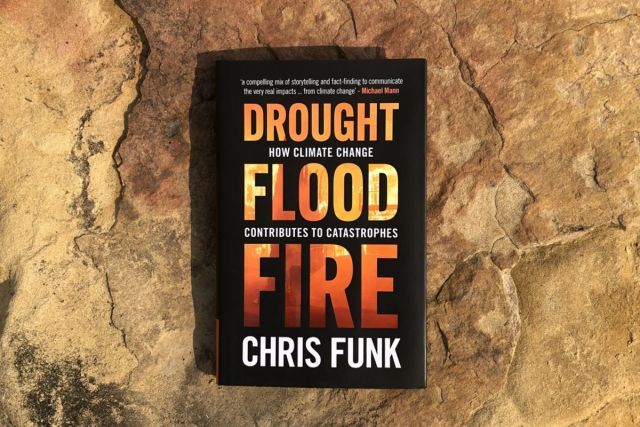‘Drought, Flood, Fire’
Researcher connects climate change science with the real-world impacts of extreme weather in his new book

Climate change is no longer a distant worry, discussed solely among scientists and environmentalists. Climate change is happening now, and it’s hurting millions of people and costing billions of dollars annually.
But the Earth is an astoundingly complex system, and tracing a line from greenhouse gas emissions through natural disasters and all the way to their effects on people is tough even for scientists, let alone the general public. Meeting that challenge is the driving force behind “Drought, Flood, Fire” (Cambridge University Press, 2021), by UC Santa Barbara’s Chris Funk, which aims to demystify how climate change contributes to catastrophes. Chaucer's Books in Santa Barbara will host Funk in an online event Aug. 24 at 7 p.m. Pacific time.
“The two main goals of the book are to communicate how climate change is really impacting us now, and then explain why that is happening,” said Funk, director of UCSB’s Climate Hazards Center. Rather than making a pronouncement on climate change from on high, Funk sought to discuss and explain the mechanisms driving it so that readers can understand the process for themselves.
The author draws upon climate data, economic impact assessments and personal accounts to explain the effects climate change is having on individuals, communities and entire societies. From 2015 to 2021, for instance, the amount of the Earth’s surface that is exceptionally warm shot from 8% to 24%, he said. And the costs of extreme events have ballooned. As described in the first chapter, the amount of weather-related damages have quadrupled since 1980, with estimated costs for 2017 and 2018 totaling $653 billion. “We’re getting to a point where the real-world cost of weather and climate hazards is approaching the cost of dealing with climate change itself,” Funk said.
“There is an old-school perception of climate change — still common among some scientists — that climate change will manifest as a ‘bathtub’ warming: a slow, gradual increase in temperatures everywhere at the same time,” Funk said. “But as a climate hazard scientist, I know that this conception is wrong. I know that this perception blunts our ability to predict and anticipate extreme events.”
Instead of thinking of climate change as a slowly warming bathtub, Funk compares it to a seesaw, alternating between highs and lows as heat and moisture circulate around the globe. “A common misconception is that global warming will just simply lift that seesaw straight up,” he said. “Whereas the latest research emphasizes that the seesaw is actually swinging up and down more violently.”
Rather than target climate cynics, Funk aimed his book toward those who are interested in understanding the impacts of climate change. “I tried to boil it down to the most important principles,” he said, “principles that anybody can understand and that really help people appreciate what’s going on.”
For instance, warm air can hold more moisture than colder air, a simple fact with profound implications. This increased capacity cuts both ways: It means the atmosphere can dump more water in wet regions and soak up more moisture from dry ones. As a result, climate change looks different depending on where you live.
The systems that transfer energy around the globe are behaving differently than they used to. While average temperatures are increasing overall, this extra energy is not necessarily distributed evenly. For example, rising temperatures have helped create a huge high-pressure dome over the Western U.S., pushing the jet stream north into Canada, Funk explained. To the east of this dome, the jet stream can bring arctic air into Eastern North America. This can help explain why the American West has been ravaged by droughts and megafires while flooding and polar vortices have battered the Midwest and East Coast.
“As grim as the whole climate change situation is, it is exciting to be working at the Climate Hazards Center,” Funk said of CHC, which supports the work of groups like the U.S. Agency for International Development. By forecasting extreme events, like droughts, the center facilitates early warnings that help humanitarian aid to be issued before circumstances become dire.
“Our work on famine prevention has taught us that if you’re willing to look at the depressing things in life, you can really help guide interventions that protect lives and livelihoods,” Funk said. “And it’s the same thing for climate change. By looking closely at the causes of climate extremes, and their links to climate change, scientists can help us cope with more droughts floods and fires.”
Contact Info:
Harrison Tasoff
(805) 893-7220
harrisontasoff@ucsb.edu
